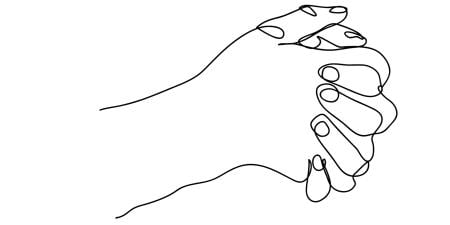Abstract
Chaplains provide spiritual care and support to patients, families, and hospital staff. What may be less familiar is that chaplains also help mediate decisions among patients, family members, and clinical teams. How clinicians, patients, and families formulate and articulate their goals and concerns can be informed either directly or indirectly by religious values. Finding common ground and common language can be helpful for both the medical team and the family. Physicians can use their clinical and social authority to try to ameliorate distress and offer recommendations based on patients’ and families’ goals and values; conversely, physicians’ hesitancy to use their authority in these ways can generate moral distress among patients, families, and caregivers. However, when the medical team engages in conversation with a willingness to be informed by patients’ religious worldview, more effective decision making may ensue.
Narrative of a Parental Dilemma
A previously healthy infant, having enjoyed the adoration of his family at home for several months, is rushed to the hospital’s emergency department. In short order he is sent to the neonatal intensive care unit (NICU). Soon he is on a ventilator. The baby undergoes a battery of tests. Within days his physicians suspect he has a rare and fatal genetic condition. Within a few more days their suspicions are confirmed; the diagnosis is like a lightning strike, so incalculable are the odds. Death is expected imminently.
The parents are observant Jews. They are active members of their community and have very close ties with their rabbi. He is a source of support and guidance to the entire family. The decisions the parents are facing are daunting, full of unknowns and uncertainties, but all leading ultimately to the same finality. The parents invite their rabbi to meetings at the hospital to help navigate the complexities of medical decision making with respect to the dictates of religious law. Given the diagnosis and prognosis, what treatments should be pursued? In matters of life and death, Jewish law is stringent; it can be complicated to stop what has been started.
At the bedside, medical options are also discussed, albeit with less formality than in the conference room. At the bedside, the parents’ hopes, fears, misgivings, and tentative aspirations are voiced to their chaplain. These parents see all too clearly how limited, now, is their baby’s future—whatever they decide to do. The wait is excruciating.
This particular family has experienced many challenges and losses in their lives. They have made difficult decisions, although perhaps none of this magnitude, which have been informed by their religious tradition, to be sure. And the family has its own culture based on unique personal experiences and predilections—the entire constellation of traits that make all of us who we are. Given the course of their baby’s decline, these parents are not inclined to prolong the suffering with heroic interventions. To them, quantity of days is inversely proportional to quality: in this case, more is much less. This is the narrative a chaplain might hear.
The parents might not express this conviction as explicitly as they could to their rabbi. Their respective goals overlap but do not align. There is an inherent conflict. The rabbi represents law in a tradition that strictly defines life and safeguards its sacredness—including longevity. The rabbi is committed to prolonging life and advocates pursuing and continuing treatment. Disappointment, ambivalence, heartbreak, and spiritual distress are not necessarily admissible factors for this legal decision-making process. To the law, life is more a binary. A person is considered alive until that person is dead. Legal adjudicators feel the same heartache as parents, but their framework is constructed differently. In short, the parents want what they want—release for their child—and they want to adhere to Jewish law as well. In some circumstances, both may not be entirely achievable.
The medical team, however skilled and sensitive, is in a precarious position in the partnered decision making they seek to elicit. All the medical information is laid out. Treatment choices and possible interventions are shared and then examined to be ruled in or out. The team appears to be acting from a point of neutrality. The family’s counsel, the rabbi, is on a predetermined course to choose more rather than less. It might reasonably appear to the medical team that elaborating and prolonging interventions, in line with the rabbi’s requests, is also what the parents want. That appearance could be misleading.
What might a chaplain do? In this case, two parallel conversations are happening—one at the bedside and one in the conference room. The chaplain has access to both. In addition, there is a possible third conversation. Parents’ goals of care can inform the options the medical team presents in the first place. In this chicken and egg scenario, the chaplain may confer with the team to clarify nuanced religious issues and to elucidate possible strategies. The medical team can use its authority and judgment in choosing and delineating treatment options—to edit them, as it were, with an understanding of the parents’ priorities. The team’s recommendations can in turn inform how rabbinic law is applied with the support of the family’s chosen counsel. A chaplain can mediate these conversations, helping the medical team members to understand the implications of the choices they offer through the lens of religious law and how asserting their medical authority might benefit achieving the family’s goals while still respecting the requirements of religious tradition. Although mediation entails tension, it can be productive tension. The ideal would be for the parents’ values, their community’s values, and the team’s medical and ethical judgment to work together and, together, to refine decision making.
In this instance, the parents empowered their rabbi to become a part of the process. Indeed, that is the ethical way to engage a third party. Here, the chaplain could contribute indirectly to the negotiation by providing deep listening and context to both team and family, thereby helping to inform and suggest limits to their decision-making process. When there is no chaplain involvement, a team may offer such a wide range of options that in the resulting moral and spiritual distress parents or clergy are “blamed” for choosing the “wrong” option. Yet this dynamic is often repeated.
A more difficult scenario, perhaps, is one in which the religious counsel is off site and has no direct contact with the patient. When decisions are seemingly dictated to the team from a remote source—from someone who has not been in the presence of patient or caregivers—the potential for misunderstanding and hard feelings increases dramatically. In extreme situations, this kind of “disjointed” decision making can take on the feel of negotiation between adversaries. Stonewalling, ultimatums, and misunderstandings may undermine direct communication, risk escalation and entrenchment, and increase duress. That the absent advisor is not witness to the patient’s experience can corrode the medical team’s trust. A chaplain can both empathize with the team while providing cultural context and redirect attention to the relevant religious legal issues.
Consider a similar but different case in which family and religious authority are completely aligned. The patient is being kept alive with aggressive and heroic measures, and there is no possibility of either recovery or consciousness. Religious counsel is effective in advocating for the medical team to continue with a “full court press.” Thus the family is spared most of the negotiating and is allowed to experience “only” the tragedy of the patient’s plight—but no further existential, religious, or moral distress. The medical team may feel manipulated and at odds with the medical options chosen or, worse, demanded of. There is a significant moral remainder in this unmediated discussion.
How might a chaplain help? It may be helpful for each side to have more nuanced understanding of the other’s culture. It may assuage some of the team’s moral distress to understand what meaning the parents ascribes to their choices. For many reasonable people and in some religious traditions, life itself is the ultimate value and goal. Quality of life of course matters, but it is only one of many variables. Even when team and family are at odds, by creating broader common ground, respect for one another can be cultivated and enhanced. Questions asked determine the answers considered. A chaplain is well situated to help ask questions that illuminate and mediate the exchange between patient, family, clergy, and physician.
The modern hospital is a compelling crucible of the complex, multicultural world in which we live. We are each at the intersection of many more cultures and influences at a given moment than we may be aware of. Even though we each use words we seem to share, in fact we may be speaking entirely different “languages.” The hospital chaplain provides insight into the world of spirituality and religion as well as the world of hospital culture to those who are unfamiliar with it—especially when neither may have been explicitly articulated. Goals of care and medical decision making are constantly evolving in whatever languages we speak.
The Place of Prayer
The Talmud—the major rabbinic compendium of Jewish law and thought redacted approximately fifteen hundred years ago—relates the story (here loosely retold) of the death of Rabbi Judah, a second century sage. After a long, miserable illness, he appears to be on the verge of death. His colleagues declare a public fast to beseech God’s mercy and prolong Rabbi Judah’s life. His students gather in his courtyard, praying that he should live. Rabbi Judah’s handmaiden goes up to the roof and prays, “Those on high (celestial beings) desire Rabbi to join them, and those below (students and sages) desire Rabbi to remain with them. May it be God’s will that those below prevail over those high.” But when she sees how much pain he is in, she changes her prayer. “May it be God’s will that those above prevail over those below.” The students do not stop praying; their prayers continue to keep Rabbi Judah alive. The handmaiden picks up a pottery jar and hurls it from the roof to the ground. As it shatters, the noise startles the students and stops their prayers for just an instant. In that instant Rabbi Judah dies, his soul departs.
In Jewish tradition, the handmaiden’s actions are seen as meritorious. It is a complicated matter for the one who prays to know what to pray for. That has not changed over the centuries. Although prayer is not the vocabulary of medicine, it articulates challenges each of us—whether patient, family, caregiver, or religious counsel—confront: how to respond to the ever-changing exigencies of life with skill, wisdom, and compassion.



